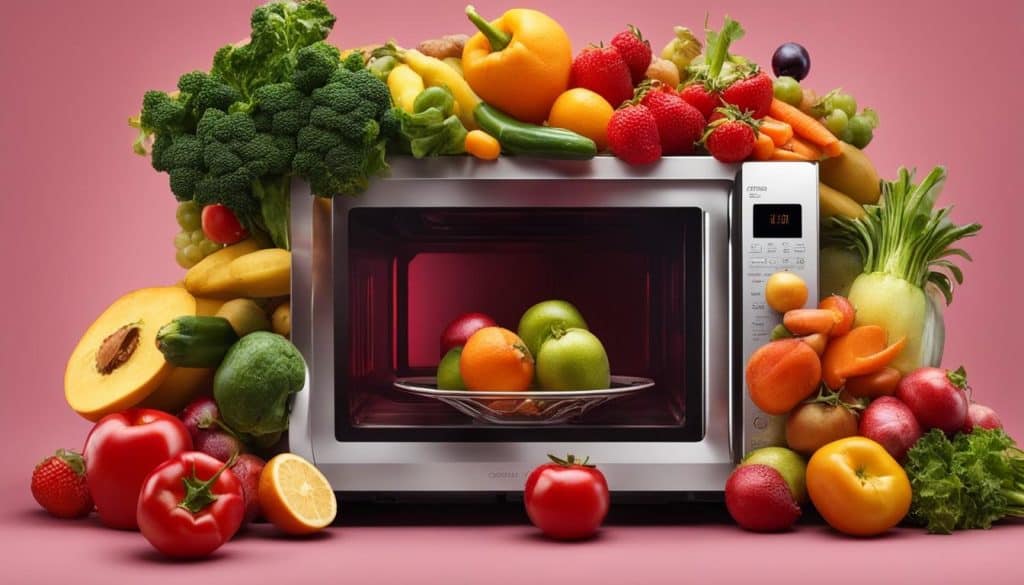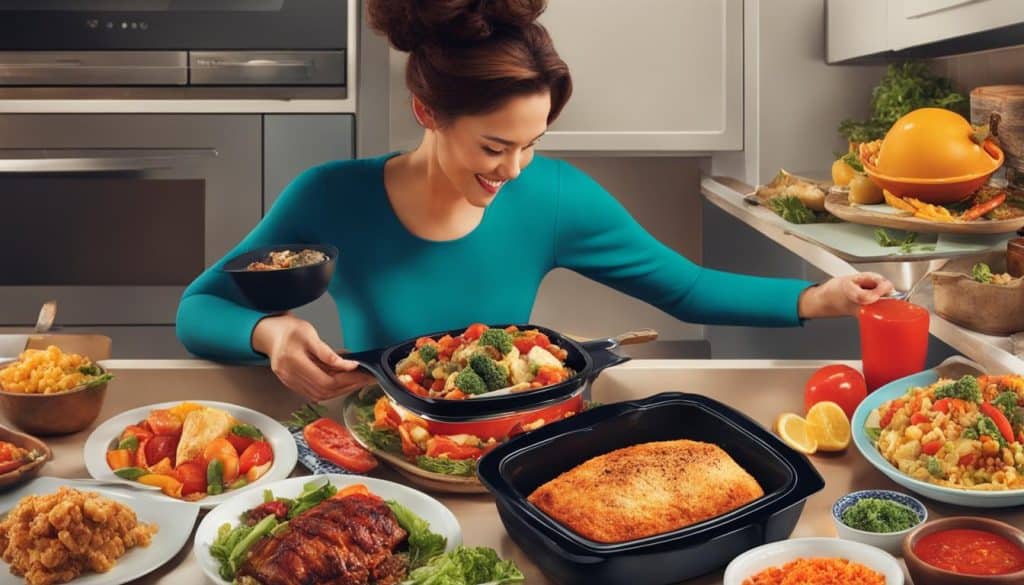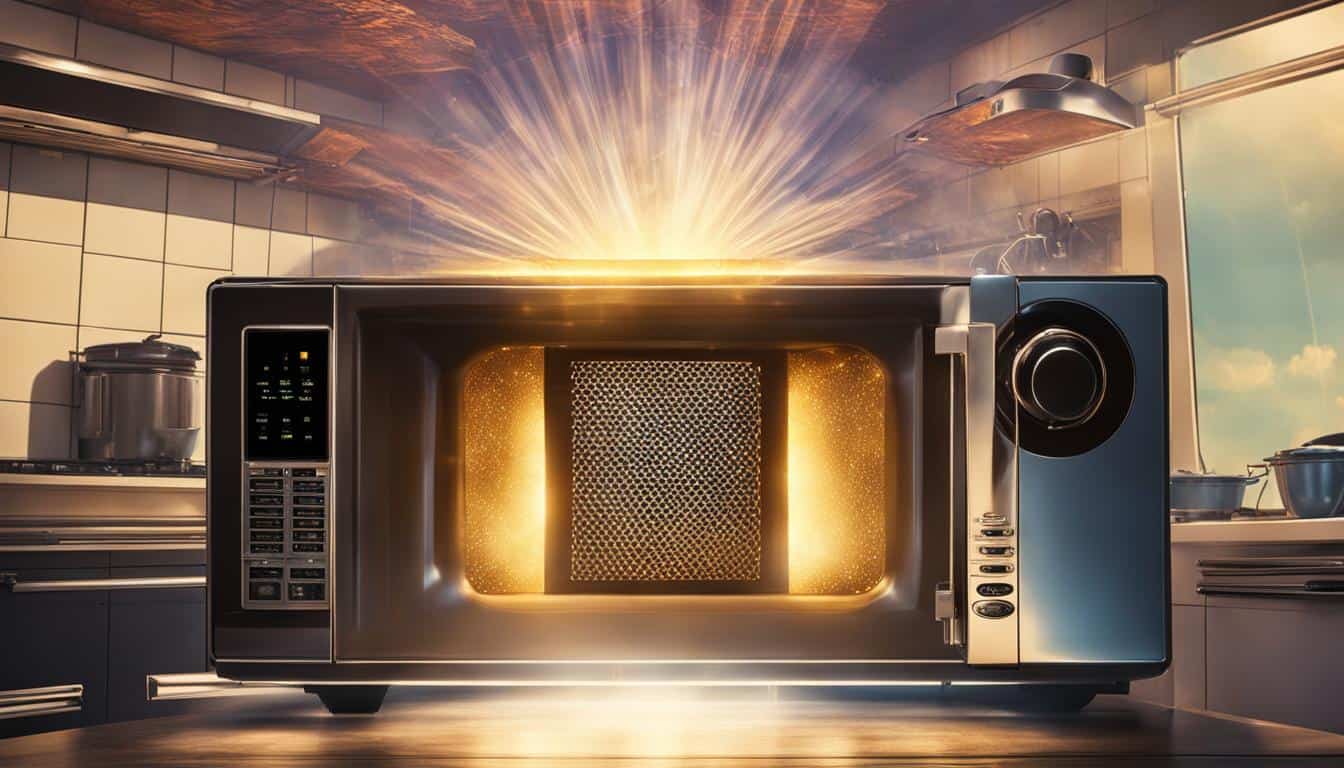Hey there, buddy! Today, we’re diving into the world of microwaves. You know, that magic box in your kitchen that heats up your pizza rolls in seconds? Well, there are tons of stories floating around about microwaves, and I’m here to separate the myths from the truths.
Have you ever heard someone say that microwaves give off dangerous radiation or that they can cause cancer? Or maybe you’ve been told that nuking your food zaps away all the good stuff, like vitamins and minerals. We’re going to explore all this and more!
Let’s start by talking about safety. Microwaves have been in our kitchens since the ’60s, and boy, have they caused a stir! Some folks worry about health risks from the radiation microwaves use to cook food.
But here’s a fun fact: the type of radiation in microwaves isn’t the same kind that superheroes get exposed to in comic books.
It’s actually a type of non-ionizing radiation, which is a fancy way of saying it’s not the kind that messes with your cells. So, no need to worry about turning into a microwave superhero anytime soon!
Now, what about the food itself? Some people think that microwaving your chow turns it into something as nutritious as cardboard. But, guess what? Cooking in a microwave can actually help keep more vitamins and minerals in your food compared to some other cooking methods.
That’s because it cooks food faster and uses less water. Just remember to use microwave-safe containers instead of random plastic ones to avoid any melty disasters. And speaking of food quality, microwaved meals can be just as tasty as other cooking methods, especially when you’re in a hurry and need something convenient and yummy.
So, next time someone tells you a scary story about your microwave, you can just smile and share the real scoop. Microwaves are safe, handy, and they keep your food nutritious and delicious. Now, go heat up those leftovers with confidence!
Myth 1: Microwaves Zap Food with Radiation, Making It Unsafe to Eat
As a copywriting journalist, I have come across several microwave myths that are still believed by many. One of the most common myths is that microwaves zap food with harmful radiation, making it unsafe to eat. However, this is far from the truth.
Microwaves do use radiation to cook food, but it’s non-ionizing radiation, which is different from the ionizing radiation used in X-rays and gamma rays. Non-ionizing radiation cannot damage DNA or cause cancer, so there’s no need to worry about the safety of your food.
In fact, microwaving your food is a much safer way to cook than other methods, as it doesn’t produce harmful carcinogens.
So, the next time someone tells you that microwaving your food is dangerous because it zaps it with harmful radiation, you can confidently tell them that they are wrong. Microwaving your food is safe, quick, and easy, making it a convenient way to cook your meals anytime.
Myth 2: Microwaves Destroy All the Nutrients in Food
Another common myth about microwaves is that they destroy all the nutrients in food, leaving you with a meal that has little to no nutritional value. While it’s true that microwaving can cause some loss of nutrients, the reality is that it is not significantly worse than other cooking methods.
In fact, microwaving can be a better way to preserve some nutrients, such as vitamin C and B vitamins, as it cooks food quickly and at lower temperatures than other methods.
According to a study published in the Journal of Food Science and Technology, microwaving broccoli retains more nutrients than boiling or pressure cooking.
The study found that microwaving broccoli with a small amount of water for two to t ee minutes was the best way to preserve its nutrient content, while boiling it for five minutes led to a 66% loss of vitamin C and a 75% loss of antioxidants.

This doesn’t mean, however, that microwaving is always the best choice for preserving nutrients in food. Certain vitamins and minerals, such as vitamin A, may not be as well-preserved when microwaving.
However, the bottom line is that microwaving is not the devil that some people make it out to be when it comes to nutrient loss in food.
Myth 3: You Can’t Cook Everything in a Microwave
Another common microwave myth is that microwaves can’t be used to cook a wide variety of dishes. While it’s true that microwaves are not ideal for everything, you might be surprised at just how many different foods you can cook in a microwave. Here are some examples:
| Food | Microwave Cooking Method |
|---|---|
| Meat, poultry, fish | Cook on high power for a few minutes per pound, or until cooked t ough |
| Vegetables | Steam in a covered dish with a small amount of water, or cook on high power for a few minutes |
| Pasta, rice | Cook in a covered dish with the appropriate amount of water, stirring occasionally, until tender |
| Desserts | Bake cakes and cookies in a microwave-safe dish on high power for a few minutes, or until cooked t ough |
As you can see, there are plenty of options when it comes to microwave cooking. Of course, some foods may not be as well-suited to the microwave as others, but that doesn’t mean you can’t experiment and find new, creative ways to use your microwave.
One thing to keep in mind is that microwaves cook food differently than other methods, so you may need to adjust cooking times and power levels to get the best results. It’s always a good idea to consult the owner’s manual for your microwave for specific cooking instructions.
The myth that you can’t cook everything in a microwave is just that – a myth. Don’t be afraid to try new things and see what works best for you and your microwave. With a little experimentation, you may find that your microwave is capable of more than you ever imagined.
Myth 5: Microwaved Food Tastes Bad
Now, this is a myth that I myself used to believe. I used to think that microwaved food tasted rubbery and unappetizing. But the truth is, it all depends on how you cook it.
Microwaved food can be just as delicious as food cooked by other methods. The key is to use the right settings and cooking times for the specific food you’re preparing. For example, microwaving a steak may not be the best idea, as it can become tough and dry.
But microwaving vegetables with a bit of seasoning and oil can result in a tasty and healthy side dish.
Another important factor to consider is the container you use to cook your food in. Using a microwave-safe dish with a lid can help seal in moisture and prevent your food from drying out. And if you’re reheating leftovers, adding a bit of water to the dish can help to keep the food from becoming too dry.
Overall, microwaved food can be just as delicious as food cooked by other methods as long as you use the right settings and techniques. Don’t let this myth stop you from enjoying the convenience of your microwave. Give it a try and see for yourself!

Myth 5: Microwaved Food Tastes Bad
One of the most common microwave myths is that microwaved food tastes bad. However, this is not necessarily true.
In fact, microwaved food can be just as delicious as food cooked by other methods. The key to making tasty microwaved food is to use the right settings and cooking times for the specific food you’re preparing.
For example, if you’re cooking vegetables, it’s important to add a bit of water and cover the container to create steam. This will help the vegetables cook evenly and retain their flavor. Another tip is to stir or rotate your food halfway t ough cooking to ensure even heating.
Additionally, there are many recipes specifically designed for microwave cooking that are both healthy and delicious. From microwave mug cakes to quick and easy microwave dinners, the possibilities are endless.
So, don’t let the myth that microwaved food tastes bad hold you back from enjoying the convenience and speed of this cooking method. With the right techniques and recipes, you can create delicious meals in minutes!

Myth 6: Leftovers That Are Reheated in a Microwave Are Not Safe to Eat
Let’s talk about reheating leftovers in a microwave. This is a common practice for many people, but some believe that it can make the food unsafe to eat. However, this is just another one of the many microwave myths that are circulating.
The truth is that reheating leftovers in a microwave is perfectly safe, as long as the food is heated to a safe temperature of 165°F. Microwaves are actually a very effective way to reheat food quickly and evenly, which can be especially helpful if you’re in a hurry or don’t have access to a stove or oven.
Of course, there are some precautions you should take when reheating leftovers in a microwave. For example, it’s important to make sure that the food is fully covered to prevent the microwave from drying it out.
You should also stir or flip the food halfway t ough to ensure that it heats evenly. And, as always, you should use a food thermometer to make sure that the food has reached a safe temperature before eating.
So, the next time you’re reheating leftovers in a microwave, know that you’re doing it safely and efficiently. Don’t let these microwave myths scare you away from using this handy kitchen appliance to make your life a little bit easier.

Myth 7: Microwaves Are Bad for the Environment
Let’s debunk another common myth about microwaves – that they’re bad for the environment. In fact, modern microwaves are actually very energy-efficient appliances. They use less energy than traditional ovens and stoves, which means they can help reduce your carbon footprint.
According to the US Department of Energy, microwaves use up to 80% less energy than a conventional oven. The reason is simple – microwaves cook food faster and more efficiently.
They don’t need to preheat, and they don’t waste heat heating up the air inside the oven. Instead, they use microwave energy to heat the food directly.
So, if you’re looking for ways to reduce your energy consumption and lower your electricity bills, using a microwave is a great place to start. Not only will you be saving money, but you’ll also be helping to protect the environment.

“Modern microwaves are actually very energy-efficient appliances. They use less energy than traditional ovens and stoves, which means they can help reduce your carbon footprint.”
Myth 8: Microwaves Cause Cancer
As a journalist, I always strive to provide accurate information based on scientific evidence. Therefore, it is important to address the widespread myth that microwaves cause cancer.
The truth is that there is no scientific evidence to support this claim. Several studies have been conducted to investigate the link between microwave use and cancer risk, and none have found any causation.
In fact, microwaves use non-ionizing radiation, which is different from the ionizing radiation used in x-rays and gamma rays. Non-ionizing radiation does not have enough energy to damage DNA or cause cancer.
It’s important to note that the Food and Drug Administration (FDA) regulates microwave ovens to ensure that they meet safety standards and limits for radiation leakage. As long as you use your microwave according to the manufacturer’s instructions, it is perfectly safe to use.
In summary, the myth that microwaves cause cancer is simply not true. As with any appliance, it’s important to follow safety guidelines and use your microwave responsibly.

Myth 10: Microwaves Are Only Good for Reheating Food
As someone who loves to cook, I used to believe that microwaves were only good for reheating leftovers. But over the years, I’ve discovered that microwaves are extremely versatile and can be used for a variety of cooking tasks.
In fact, microwaves can be a lifesaver when you’re short on time or don’t feel like using your oven. One of my favorite things to cook in the microwave is a baked potato. Simply scrub the potato, poke several holes in it with a fork, wrap it in a damp paper towel, and microwave on high for 5-7 minutes. You’ll have a perfectly cooked potato in no time!
Another great use for microwaves is steaming vegetables. Simply add your veggies to a microwave-safe bowl with a splash of water, cover with a microwave-safe lid or plastic wrap, and microwave on high for a few minutes. Voila! Steamed veggies without any fuss.
If you’re a fan of frozen meals, you can also use your microwave to cook them. Simply follow the instructions on the package and you’ll have a delicious meal in minutes.
My Experience with Microwaves
Personally, I’ve found that some microwaves can be a bit tricky to use. However, once you get the hang of it, they’re actually very easy to operate. Most microwaves have simple controls and clear instructions, so don’t be intimidated by all the buttons and settings.
If you’re not sure where to start, try experimenting with some simple recipes. You’ll be surprised at how many delicious meals you can make in the microwave!

Myth 10: Microwaves Are Only Good for Reheating Food
Many people believe that microwaves are only good for reheating food, but this couldn’t be further from the truth. Microwaves can be used for a variety of cooking tasks that go far beyond reheating leftovers.
Cooking Frozen Meals
If you’re short on time, microwaves are an excellent option for cooking frozen meals. Simply follow the cooking instructions on the package, and you’ll have a hot and delicious meal in minutes.
Defrosting Food
Microwaves are also great for defrosting food quickly. Simply place the frozen food in a microwave-safe dish and use the defrost setting. Be sure to follow the instructions for your specific microwave to ensure that the food is defrosted evenly and thoroughly.
Steaming Vegetables
Microwaves can be used for steaming vegetables, which is a healthy and quick way to cook them. Simply place the vegetables in a microwave-safe dish with a small amount of water and cover with a microwave-safe lid or plastic wrap. Cook on high for a few minutes, until the vegetables are tender.
Baking Cakes and Cookies
Believe it or not, you can even use your microwave for baking. There are many recipes available online for cakes and cookies that can be baked in a microwave. This is a great option if you don’t have access to an oven or if you want to save time.
As you can see, microwaves are good for more than just reheating food. They can be used for a variety of cooking tasks and are a convenient and efficient way to prepare meals. So, don’t limit yourself to just reheating leftovers. Get creative and explore all that your microwave can do!


